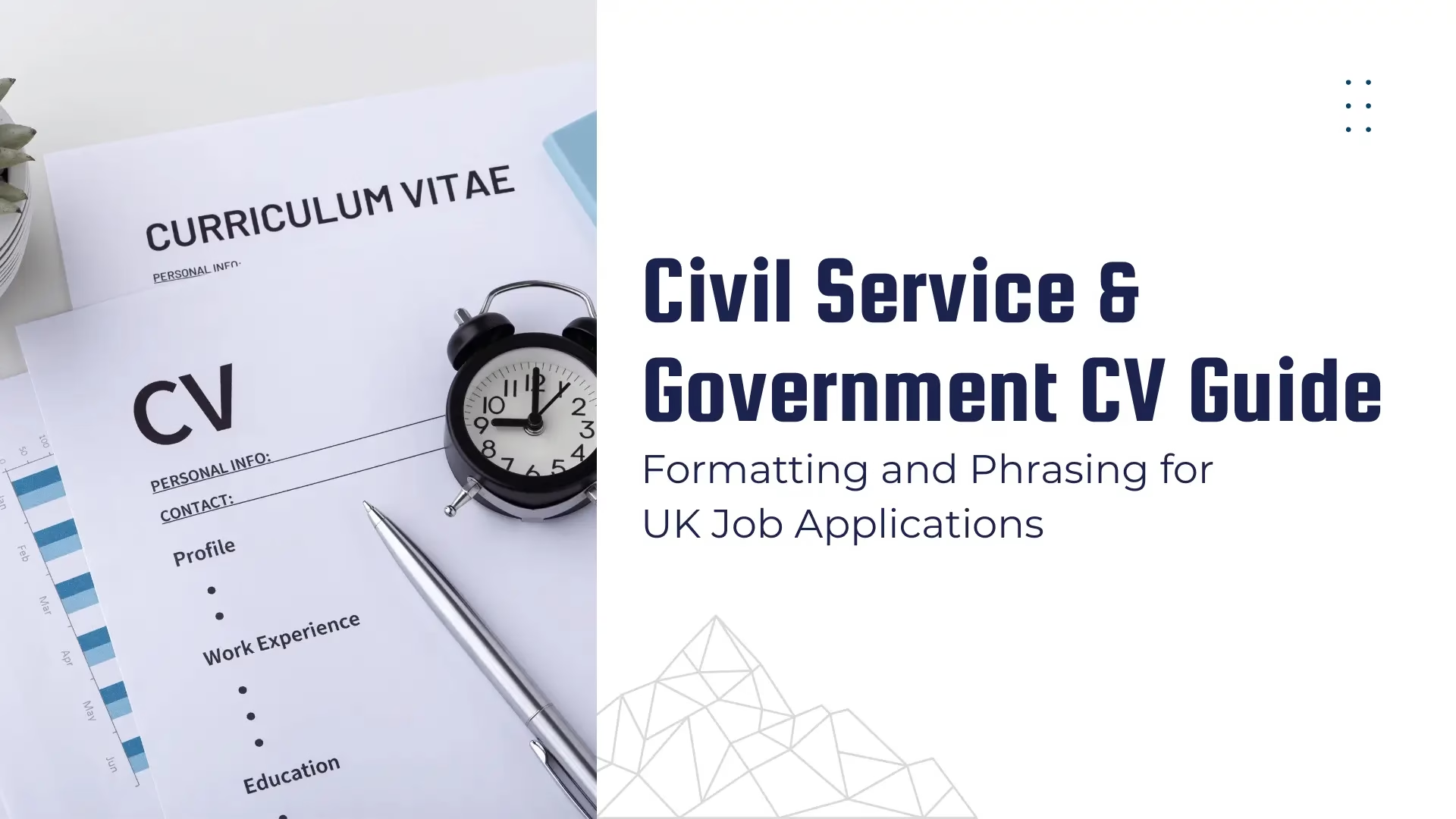Introduction
Applying for a role in the UK Civil Service or wider government sector requires more than just a polished CV. Unlike traditional corporate applications, civil service CVs are assessed against strict frameworks, including the Success Profiles system. That means your CV is not simply a career history—it’s evidence that you meet job-specific criteria with precision. A poorly formatted or vague CV could mean being sifted out, even if you have the right skills.
This guide will show you how to craft a winning Civil Service and government CV, from formatting and phrasing to tailoring for Success Profiles and competency-based assessments. We will cover structure, examples, mistakes to avoid, and insider tips to help you pass sift and get invited to interview. By the end, you will know exactly how to create a compelling Civil Service CV that gets noticed.
Why Civil Service CVs Are Different
What Makes a Civil Service CV Unique?
Civil Service job applications differ from private-sector CVs because they are designed to test fairness, transparency, and consistency. Recruiters must assess applications against measurable criteria, meaning vague claims won’t pass.
Key differences include:
- Structured frameworks: Civil Service uses the Success Profiles framework (strengths, behaviours, skills, experience).
- Plain English: Clear, jargon-free phrasing is essential.
- Evidence-based: Every bullet point should show results or outcomes.
- Word counts: Strict limits on CV sections or supporting statements.
Why Formatting Matters
Government recruiters often scan hundreds of applications. A poorly formatted CV makes their job harder and reduces your chances. Consistency in headings, spacing, and fonts improves readability and makes your evidence stand out.
How to Format a Civil Service CV
Length and Structure
- Length: Aim for 2 pages maximum.
- Font: Use Arial, Calibri, or Verdana (size 11–12).
- Margins: Standard 2.5 cm for readability.
Essential Sections
- Contact Information (top of page, no photos required)
- Professional Profile (short summary tailored to Civil Service role)
- Key Skills (aligned with Success Profiles)
- Employment History (evidence-driven bullet points)
- Education and Training
- Additional Information (security clearance, volunteering, languages)
Example Layout
Professional Profile Experienced policy advisor with 5 years’ experience in stakeholder engagement, delivering policy change, and supporting government decision-making. Skilled in drafting ministerial briefings and managing cross-departmental projects.
Key Skills
- Policy Analysis and Development
- Stakeholder Management
- Strong Communication (oral and written)
- Data Interpretation and Reporting
Phrasing for Success Profiles
What Are Success Profiles?
The UK Civil Service recruitment framework includes:
- Behaviours (e.g., Seeing the Big Picture, Delivering at Pace)
- Strengths (personal qualities)
- Experience (work history)
- Technical Skills (role-specific knowledge)
Phrasing Examples
Instead of writing: “Responsible for policy development.” Write: “Led policy development on health initiatives, resulting in a 15% increase in programme uptake across three regions.”
This phrasing shows:
- Action (led)
- Context (health initiatives)
- Outcome (15% increase)
STAR Method for Evidence
- Situation: Context of your example
- Task: What you needed to do
- Action: What you did
- Result: Outcome and impact
Example: Situation: Managed a cross-government project on climate change.
Task: Deliver a national report for ministers.
Action: Coordinated input from 7 departments and produced the final draft ahead of deadline.
Result: Report informed ministerial decisions and secured funding for sustainability projects worth £50m.
Pros and Cons of the Civil Service CV Format
Pros:
- Ensures fairness through structured evaluation
- Focuses on evidence, not self-promotion
- Recognised across all government departments
Cons:
- Time-consuming to tailor
- Strict limits can feel restrictive
- Requires understanding of Success Profiles
Common Civil Service CV Mistakes
- Using corporate buzzwords like “dynamic” or “results-driven” without evidence.
- Submitting overlong CVs that exceed 2 pages.
- Failing to tailor experience to Success Profiles.
- Overusing technical jargon instead of plain English.
- Not quantifying achievements.
Step-by-Step Guide: Writing a Civil Service CV
Step 1: Read the Job Description Carefully
Identify which Success Profiles are being assessed. Highlight behaviours and skills.
Step 2: Tailor Your Professional Profile
Use keywords from the job ad. Keep it role-specific.
Step 3: List Evidence-Based Skills
Match each skill with measurable outcomes.
Step 4: Rewrite Work History in STAR Format
Turn responsibilities into achievements with results.
Step 5: Review and Edit
Check spelling, clarity, and formatting. Ask a colleague to review.
Expert Insights
- According to a 2023 Civil Service survey, 65% of applicants fail at the sift stage because their CV does not demonstrate evidence clearly.
- Recruiters spend an average of 7 seconds scanning each CV. Formatting and phrasing are critical.
- CVs written with STAR examples are 3x more likely to progress.
Trends in UK Civil Service Recruitment 2025
- Increasing use of AI screening for keyword matching.
- More emphasis on behaviours and strengths than purely technical skills.
- Demand for skills in digital transformation, data analysis, and policy evaluation.
Internal Linking Suggestions
- Link to related blogs such as “How to Write Civil Service Personal Statements” or “Civil Service Interview Questions and Answers.”
- Link to services like “Professional CV Writing for Government Jobs.”
External References
- UK Government Civil Service Careers site: https://www.civil-service-careers.gov.uk/
- Success Profiles guidance: https://www.gov.uk/government/publications/success-profiles
Conclusion
A Civil Service CV is not just a job application—it’s a demonstration of your ability to meet government frameworks, show evidence, and communicate clearly. By mastering formatting, phrasing with evidence, and aligning with Success Profiles, you dramatically increase your chances of progressing through the sift and securing interviews.
Start with a clear structure, apply STAR examples, and avoid common pitfalls. Whether you are applying for an entry-level role or a senior policy advisor position, this guide gives you the tools to succeed.
Ready to stand out in Civil Service recruitment? Get your CV written by experts today and take the first step toward your government career.
FAQs
1. How long should a Civil Service CV be?
Maximum 2 pages, concise and evidence-driven.
2. Do I need a photo on my Civil Service CV?
No, photos are unnecessary and not recommended.
3. How do I tailor my CV for Success Profiles?
Match examples to behaviours, skills, and strengths listed in the job ad.
4. Should I use bullet points or paragraphs?
Bullet points are preferred for clarity and scannability.
5. What font should I use for a Civil Service CV?
Arial, Calibri, or Verdana, size 11–12 for readability.
6. Can I reuse the same CV for multiple Civil Service jobs?
No, each application must be tailored to the specific role.
7. Do I include volunteering experience?
Yes, especially if it demonstrates behaviours or skills relevant to the job.
8. How are Civil Service CVs assessed?
Recruiters use Success Profiles to score your evidence against job requirements.
9. Should I include references on my Civil Service CV?
No, references are requested later in the process.
10. What is the biggest mistake applicants make?
Not providing measurable evidence in their examples.

